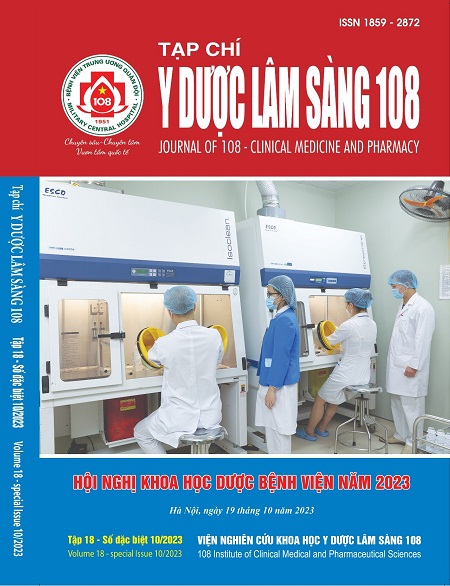Investigation on antibiotic use in the treatment ofacute cholangitis and acute cholecystitisat the Gia Dinh People’s Hospital
Main Article Content
Keywords
Abstract
Objective: To investigate the antibiotic use in patients with acute cholangitis or acute cholecystitis at the Gia Dinh People’s Hospital. Subject and method: A retrospective, descriptive study was performed on clinical data of 50 inpatients with acute cholangitis and 65 inpatients with acute cholecystitis treated at the Gia Dinh People’s Hospital from January 1st, 2022 to March 31st, 2022. Result: The rate of indication for microbiological culture was 36.5%. The most common bacterial isolates were Escherichia coli (33.3%) and Klebsiella pneumoniae (33.3%). Most patients were prescribed therapeutic antibiotics (94.8%). The most common empiric antibiotics included metronidazole (60.6%), cephalosporins (47.7%). The majority of patients were combined 2 antibiotics (61.5%), mostly the combination of metronidazole and a beta-lactam (60.6%). Among those patients, the combination rate of metronidazole with another antibiotic that has spectrum on anaerobic bacteria was high (40.4%). The proportion of patients with antibiotic prescriptions at hospital discharge was 68.8%, mostly cefixime (61.4%). Conclusion: The rate of microbiological testing in patients with acute cholangitis or acute cholecystitis was low. The majority of patients were prescribed a combination of 2 antibiotics. It is necessary to strengthen drug information activities at the hospital to prevent unnecessary combinations of metronidazole
Article Details
References
2. Mayumi T, Okamoto K, Takada T et al (2018) Tokyo Guidelines 2018: Management bundles for acute cholangitis and cholecystitis. Journal of Hepato-Biliary-Pancreatic Sciences 25(1): 96-100.
3. Gomi H, Solomkin JS, Schlossberg D et al (2018) Tokyo Guidelines 2018: Antimicrobial therapy for acute cholangitis and cholecystitis. J Hepatobiliary Pancreat Sci 25(1): 3-16.
4. Giles AE, Godzisz S, Nenshi R et al (2020) Diagnosis and management of acute cholecystitis: A single-centre audit of guideline adherence and patient outcomes. Can J Surg 63(3): 241-249.
5. Murata A, Matsuda S, Kuwabara K et al (2011) Evaluation of compliance with the Tokyo Guidelines for the management of acute cholangitis based on the Japanese administrative database associated with the Diagnosis Procedure Combination system. J Hepatobiliary Pancreat Sci 18(1): 53-59.
6. Kiriyama S, Kozaka K, Takada T et al (2018) Tokyo Guidelines 2018: diagnostic criteria and severity grading of acute cholangitis (with videos). J Hepatobiliary Pancreat Sci 25(1): 17-30.
7. Yokoe M, Hata J, Takada T et al (2018) Tokyo Guidelines 2018: diagnostic criteria and severity grading of acute cholecystitis (with videos). J Hepatobiliary Pancreat Sci 25(1): 41-54.
8. Kimura Y, Takada T, Kawarada Y et al (2007) Definitions, pathophysiology, and epidemiology of acute cholangitis and cholecystitis: Tokyo Guidelines. J Hepatobiliary Pancreat Surg 14(1):15-26.
9. Shaffer EA (2006) Epidemiology of gallbladder stone disease. Best Practice & Research Clinical Gastroenterology 20(6): 981-996.
10. Suh SW, Choi YS, Choi SH et al (2021) Antibiotic selection based on microbiology and resistance profiles of bile from gallbladder of patients with acute cholecystitis. Sci Rep 11(1): 2969.
11. Kimura Y, Takada T, Strasberg SM et al (2013) TG13 current terminology, etiology, and epidemiology of acute cholangitis and cholecystitis. Journal of Hepato-Biliary-Pancreatic Sciences 20(1): 8-23.
12. Kwon JS, Han J, Kim TW et al (2014) Changes in causative pathogens of acute cholangitis and their antimicrobial susceptibility over a period of 6 years. Korean J Gastroenterol 63(5): 299-307.
13. Shenoy SM, Shenoy S, Gopal S et al (2014) Clinicomicrobiological analysis of patients with cholangitis. Indian J Med Microbiol 32(2): 157-160.
14. The Sanford Guide: 51st edition (2022) Antimicrobial Therapy.
 ISSN: 1859 - 2872
ISSN: 1859 - 2872
